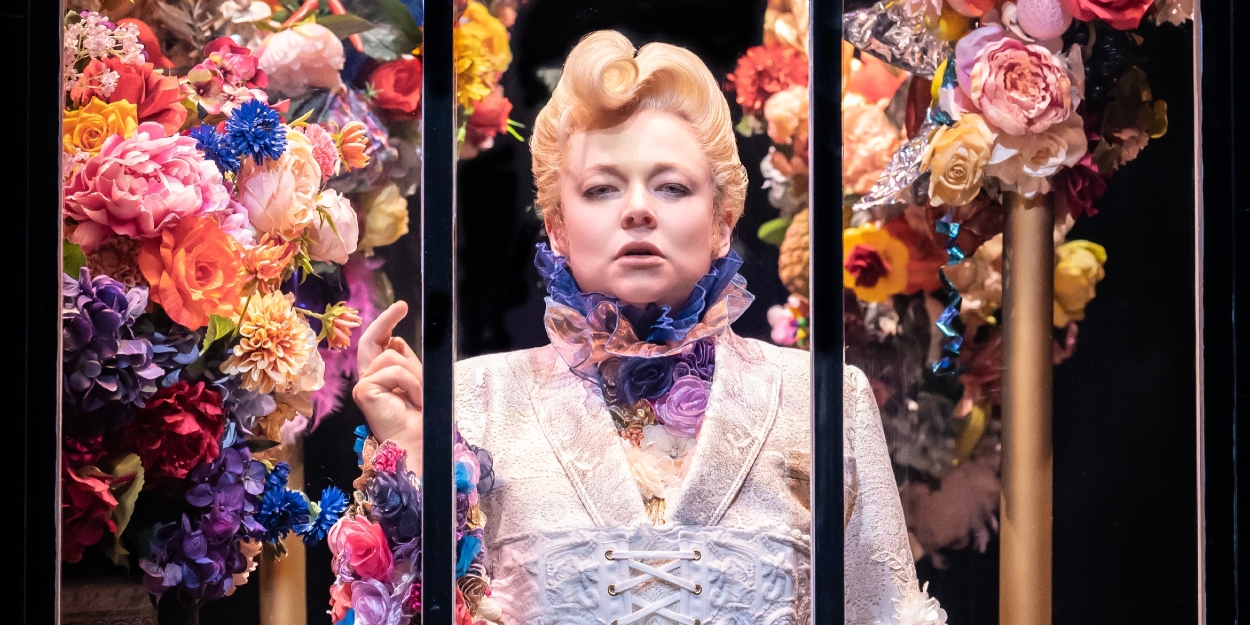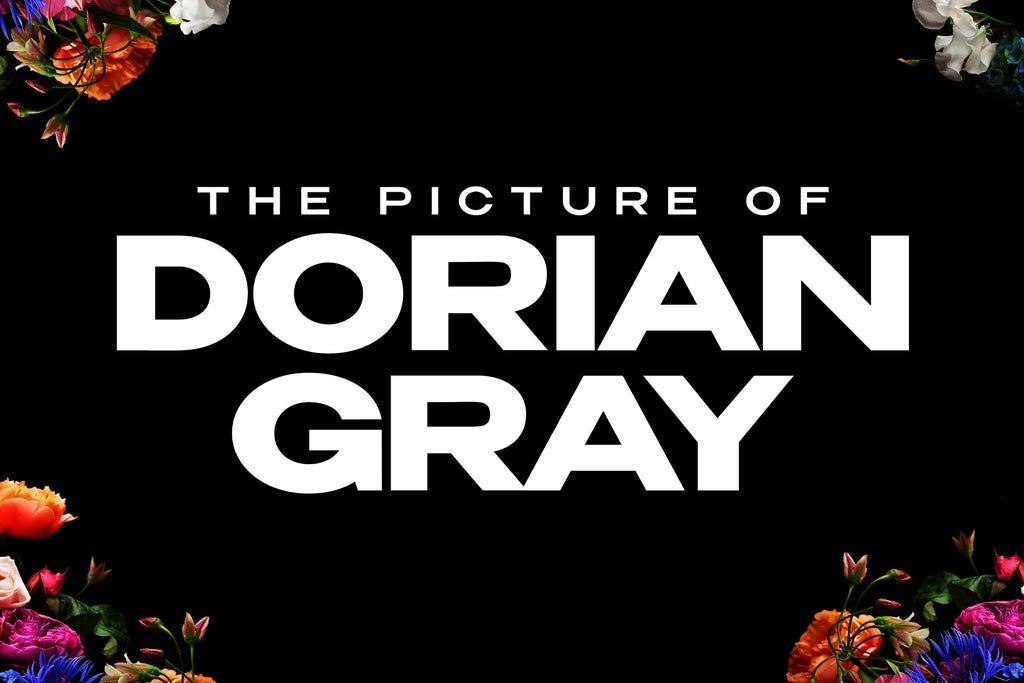Review Roundup: Sarah Snook Stars In THE PICTURE OF DORIAN GRAY On Broadway
This new adaptation is written and directed by Kip Williams.

Oscar Wilde’s tale of beauty, excess, and a deal with the devil comes to Broadway in The Picture of Dorian Gray, starring Emmy Award-winner Sarah Snook. Check out what the critics had to say about the New York premiere of this acclaimed production!
The production comes to Broadway following a sold-out run in London’s West End. Snook, who won the 2024 Olivier Award for her performance, makes her Broadway debut playing 26 characters in this breathtaking adaptation of Oscar Wilde’s only novel.
Snook was most recently seen as Shiv Roy in the hit series “Succession,” a role that earned her global acclaim. Over the show's four seasons, she received an Emmy Award, two Golden Globe Awards and a Critics Choice Award.
The celebrated world premiere of The Picture of Dorian Gray in 2020 extended twice in Sydney and toured to critical and audience acclaim throughout Australia. Last year in London, The Picture of Dorian Gray was adored by critics and audiences alike and earned Snook a Best Actress Olivier Award and a Best Costume Design Olivier Award for Marg Horwell.
Set and Costume Design is by Marg Horwell, Lighting Design by Nick Schlieper, Composition & Sound Design by Clemence Williams, Video Design by David Bergman and Eryn Jean Norvill as Dramaturg & Creative Associate.
![]() Jesse Green, The New York Times: Yet it’s not technology itself that leaves “Dorian Gray” feeling so brittle where “Vanya” is a tear fest. It’s that the technology dominates all other values, including Wilde’s, often denying the human contact, and contract, that are at the heart of theater’s effectiveness. Some important scenes, though shot live onstage, must be watched onscreen because the screen itself blocks the upper half of Snook’s body. Her giant face is rendered in such super close-up that you might as well be an otolaryngologist; only her legs are left to do IRL acting.
Jesse Green, The New York Times: Yet it’s not technology itself that leaves “Dorian Gray” feeling so brittle where “Vanya” is a tear fest. It’s that the technology dominates all other values, including Wilde’s, often denying the human contact, and contract, that are at the heart of theater’s effectiveness. Some important scenes, though shot live onstage, must be watched onscreen because the screen itself blocks the upper half of Snook’s body. Her giant face is rendered in such super close-up that you might as well be an otolaryngologist; only her legs are left to do IRL acting.
![]() Christian Lewis, Variety: At its core, then, if the production doesn’t utilize its technology for commentary and is hampered rather than strengthened by its single-actor format, what’s left? The very premise of the production is a gimmick, a way to let an actor show off and dazzle the audience with some tricks. It’s an empty spectacle, though, and it remains unclear what – if anything – the production is trying to say other than that vanity is bad.
Christian Lewis, Variety: At its core, then, if the production doesn’t utilize its technology for commentary and is hampered rather than strengthened by its single-actor format, what’s left? The very premise of the production is a gimmick, a way to let an actor show off and dazzle the audience with some tricks. It’s an empty spectacle, though, and it remains unclear what – if anything – the production is trying to say other than that vanity is bad.
![]() David Cote, Observer: Since Snook’s eyeline often goes straight to the camera, as characters in close-up or when Dorian stares at his portrait, the identity of the screen itself grows slippery. When Snook looks at the portrait, she’s looking at the audience, as if through a portal. She and we are simultaneous stand-ins for the enchanted canvas: two black mirrors gazing narcissistically into each other’s fatal depths.
David Cote, Observer: Since Snook’s eyeline often goes straight to the camera, as characters in close-up or when Dorian stares at his portrait, the identity of the screen itself grows slippery. When Snook looks at the portrait, she’s looking at the audience, as if through a portal. She and we are simultaneous stand-ins for the enchanted canvas: two black mirrors gazing narcissistically into each other’s fatal depths.
![]() Greg Evans, Deadline: Equal parts acting masterclass, tech wizardry, illusion and clockwork stage management, all costumed and set designed with the wit and color schemes of the most vivid Cindy Sherman photographs, Dorian Gray marks audacious Broadway debuts by both Snook and director-adaptor Kip Williams.
Greg Evans, Deadline: Equal parts acting masterclass, tech wizardry, illusion and clockwork stage management, all costumed and set designed with the wit and color schemes of the most vivid Cindy Sherman photographs, Dorian Gray marks audacious Broadway debuts by both Snook and director-adaptor Kip Williams.
![]() Chris Jones, The New York Daily News: Those digital selves are rendered on separate screens of various shapes and sizes, aptly resembling pictures in, say, the National Portrait Gallery. They’re kinetic, flying in and out, landing at different angles, sometimes rendering whole bodies in silhouette and, at others, offering a series of characters at a gossipy table. All are richly realized, down to the mutton-chop mustaches (in some cases) or the elaborate headwear (in others). All, of course, are played by Snook. Unless you saw this piece in London, I doubt you will have seen quite the like before.
Chris Jones, The New York Daily News: Those digital selves are rendered on separate screens of various shapes and sizes, aptly resembling pictures in, say, the National Portrait Gallery. They’re kinetic, flying in and out, landing at different angles, sometimes rendering whole bodies in silhouette and, at others, offering a series of characters at a gossipy table. All are richly realized, down to the mutton-chop mustaches (in some cases) or the elaborate headwear (in others). All, of course, are played by Snook. Unless you saw this piece in London, I doubt you will have seen quite the like before.
![]() Adam Feldman, Time Out New York: Performed in a single two-hour burst, The Picture of Dorian Gray is a marvel of coordination. For much of the night, Snook acts opposite prerecorded clips of herself as other characters, which appear on video screens that float beside her or above her head; the parts of her performance that are delivered in real time onstage are frequently filmed live and displayed on those same screens.
Adam Feldman, Time Out New York: Performed in a single two-hour burst, The Picture of Dorian Gray is a marvel of coordination. For much of the night, Snook acts opposite prerecorded clips of herself as other characters, which appear on video screens that float beside her or above her head; the parts of her performance that are delivered in real time onstage are frequently filmed live and displayed on those same screens.
![]() Jonathan Mandell, New York Theater: Sarah Snook portrays some 25 characters as well as the narrator in this dazzling and sometimes dizzying stage-and-video adaptation of Oscar Wilde’s novel, but at the curtain call, she is far from alone: Fourteen other people, all dressed in black, take their bows with her...They, and especially video designer David Bergman, also help turn writer and director Kip Williams’s adaptation of “The Picture of Dorian Gray” into a visually clever, technically sophisticated production for which “solo play” feels like an inadequate description.
Jonathan Mandell, New York Theater: Sarah Snook portrays some 25 characters as well as the narrator in this dazzling and sometimes dizzying stage-and-video adaptation of Oscar Wilde’s novel, but at the curtain call, she is far from alone: Fourteen other people, all dressed in black, take their bows with her...They, and especially video designer David Bergman, also help turn writer and director Kip Williams’s adaptation of “The Picture of Dorian Gray” into a visually clever, technically sophisticated production for which “solo play” feels like an inadequate description.
![]() Shania Russell, Entertainment Weekly: Though Snook is the show's undeniable star, she has stiff competition: Director Kip Williams' is also a standout. The meticulous direction goes hand in hand with Snook's performance and strikes a fascinating balance. Polished as it must be — to seamlessly pull off her collaboration with her video selves — it doesn't quite feel precise, often presenting with an element of messiness that suits Dorian, as he wallows in his moral decay, frazzled by the Faustian trade he's made, by the power it affords him, by his own detachment from the rest of humanity.
Shania Russell, Entertainment Weekly: Though Snook is the show's undeniable star, she has stiff competition: Director Kip Williams' is also a standout. The meticulous direction goes hand in hand with Snook's performance and strikes a fascinating balance. Polished as it must be — to seamlessly pull off her collaboration with her video selves — it doesn't quite feel precise, often presenting with an element of messiness that suits Dorian, as he wallows in his moral decay, frazzled by the Faustian trade he's made, by the power it affords him, by his own detachment from the rest of humanity.
![]() Johnny Oleksinki, The New York Post: But what the worthwhile play offers — and I know there are many who pooh-pooh screens onstage as a rule — is the childlike wonderment of not understanding the logistics of what you’re looking at. The first hour is marked by awed and confused “How did they do that?”s. “How did she do that?”
Johnny Oleksinki, The New York Post: But what the worthwhile play offers — and I know there are many who pooh-pooh screens onstage as a rule — is the childlike wonderment of not understanding the logistics of what you’re looking at. The first hour is marked by awed and confused “How did they do that?”s. “How did she do that?”
![]() Allison Considine, New York Theatre Guide: Snook tackles dozens of roles with remarkable aplomb, from a cynical aristocrat to a Cockney maid to the dynamic protagonist and beyond. This is where the cameras come in: the live Snook shares scenes with pre-recorded footage of herself. The camera also captures her performance in real time, portraying her expressive face on large screens suspended above the stage. Almost like a 19th-century portrait.
Allison Considine, New York Theatre Guide: Snook tackles dozens of roles with remarkable aplomb, from a cynical aristocrat to a Cockney maid to the dynamic protagonist and beyond. This is where the cameras come in: the live Snook shares scenes with pre-recorded footage of herself. The camera also captures her performance in real time, portraying her expressive face on large screens suspended above the stage. Almost like a 19th-century portrait.
![]() Joey Sims, Theatrely: Certainly this Dorian Gray is an astonishing technical achievement. A powerhouse Sarah Snook, fresh off HBO’s mega-hit Succession, plays all the parts in the 2-hour, intermission-less spin on Wilde’s novel, a horror-infused fantasy of eternal beauty’s curse. Snook achieves that feat by performing opposite many pre-recorded versions of herself, projected on a multitude of screens that glide above and around the stage. Snook herself is also trailed by a hard-working camera crew, her own transformative work sharing the same screens with her pre-filmed selves.
Joey Sims, Theatrely: Certainly this Dorian Gray is an astonishing technical achievement. A powerhouse Sarah Snook, fresh off HBO’s mega-hit Succession, plays all the parts in the 2-hour, intermission-less spin on Wilde’s novel, a horror-infused fantasy of eternal beauty’s curse. Snook achieves that feat by performing opposite many pre-recorded versions of herself, projected on a multitude of screens that glide above and around the stage. Snook herself is also trailed by a hard-working camera crew, her own transformative work sharing the same screens with her pre-filmed selves.
![]() Michael Sommers, New York Stage Review: Midway through the tale as self-besotted Dorian plunges into a hedonistic rave of cocaine, disco music and fuchsia lighting, Snook raises on high a mobile phone and wildly whirls around the stage, grabbing selfies that light up all of the screens. The camera filters soon blow up Dorian’s features with grotesque lips and eyes; images initially comical and then growing monstrous, especially when projected across multiple surfaces. It is a disturbing, brilliant sequence reflecting the mad narcissism at the heart of the dark tale.
Michael Sommers, New York Stage Review: Midway through the tale as self-besotted Dorian plunges into a hedonistic rave of cocaine, disco music and fuchsia lighting, Snook raises on high a mobile phone and wildly whirls around the stage, grabbing selfies that light up all of the screens. The camera filters soon blow up Dorian’s features with grotesque lips and eyes; images initially comical and then growing monstrous, especially when projected across multiple surfaces. It is a disturbing, brilliant sequence reflecting the mad narcissism at the heart of the dark tale.
![]() Roma Torre, New York Stage Review: This is not story theater as one might imagine. It is a wondrous merging of technical wizardry, clever stagecraft and incomparable artistry. As you enter the theater, there’s little more than a giant screen suspended on a bare stage. When it begins, we hear Snook’s voice narrating the scene set in an artist’s studio as we meet the artist Basil Hallward and his friend Lord Henry Wotton discussing Basil’s portrait of Dorian Gray, a young man they find “wonderfully handsome.” Snook appears on the giant screen as Dorian, and magically she also becomes the two older men as they all converse about “a new hedonism” that worships the beauty of youth above all else.
Roma Torre, New York Stage Review: This is not story theater as one might imagine. It is a wondrous merging of technical wizardry, clever stagecraft and incomparable artistry. As you enter the theater, there’s little more than a giant screen suspended on a bare stage. When it begins, we hear Snook’s voice narrating the scene set in an artist’s studio as we meet the artist Basil Hallward and his friend Lord Henry Wotton discussing Basil’s portrait of Dorian Gray, a young man they find “wonderfully handsome.” Snook appears on the giant screen as Dorian, and magically she also becomes the two older men as they all converse about “a new hedonism” that worships the beauty of youth above all else.
![]() Robert Hofler, The Wrap: Williams’ adaptation follows Wilde’s original story more closely than the 1945 MGM movie starring George Sanders as Lord Henry and Hurd Hatfield as Dorian. Hatfield does something unexpected in that horror classic: His face throughout remains a tabula rasa. The actor lets the painting do all the acting. Snook takes a very different approach. She eschews the blond curls halfway through the show to don a slick pompadour that’s closer to what Glynis Johns sports in “The Chapman Report.” Snook also goes full-throttle to tear up the stage, even though there isn’t much scenery to put through her acting shredder.
Robert Hofler, The Wrap: Williams’ adaptation follows Wilde’s original story more closely than the 1945 MGM movie starring George Sanders as Lord Henry and Hurd Hatfield as Dorian. Hatfield does something unexpected in that horror classic: His face throughout remains a tabula rasa. The actor lets the painting do all the acting. Snook takes a very different approach. She eschews the blond curls halfway through the show to don a slick pompadour that’s closer to what Glynis Johns sports in “The Chapman Report.” Snook also goes full-throttle to tear up the stage, even though there isn’t much scenery to put through her acting shredder.
![]() Patrick Ryan, USA Today: Despite the show’s overreliance on whiz-bang technology, Snook is never anything less than jaw-dropping. The Australian actress tackles the prodigious task at hand with breathtaking precision, believably engaging in verbose conversations with her digitalized selves, and never missing a beat as she plays to each and every camera that’s ceaselessly roving and whirring around her.
Patrick Ryan, USA Today: Despite the show’s overreliance on whiz-bang technology, Snook is never anything less than jaw-dropping. The Australian actress tackles the prodigious task at hand with breathtaking precision, believably engaging in verbose conversations with her digitalized selves, and never missing a beat as she plays to each and every camera that’s ceaselessly roving and whirring around her.
![]() Sara Holdren, Vulture: It’s a mark of Williams’s savvy—combined with the expert calibrations of his adaptation’s solo performer, Sarah Snook—that neither this moment nor any other in the show is approached with the heavy highlighter of relevancy. Wilde, with his withering disdain for moral snobbery, would have hated that, and this Dorian Gray stays true to its originator’s brilliant ghost, even as it winkingly inserts a phone selfie here and a creepy TikTok filter there. The show arrives on Broadway trailing acclaim from its London run, including an Olivier for Snook, and it works because it is, first and foremost, a sensory feast. Fast, clever, delicious, and performed by Snook with the giddy virtuosity of Simone Biles executing a floor routine, it reaches the gut and the heart lightly, thrusting like a fencer, by way of its playfulness and spectacle. It doesn’t need a bullhorn to talk about the now — just a great story and an acrobatic actor.
Sara Holdren, Vulture: It’s a mark of Williams’s savvy—combined with the expert calibrations of his adaptation’s solo performer, Sarah Snook—that neither this moment nor any other in the show is approached with the heavy highlighter of relevancy. Wilde, with his withering disdain for moral snobbery, would have hated that, and this Dorian Gray stays true to its originator’s brilliant ghost, even as it winkingly inserts a phone selfie here and a creepy TikTok filter there. The show arrives on Broadway trailing acclaim from its London run, including an Olivier for Snook, and it works because it is, first and foremost, a sensory feast. Fast, clever, delicious, and performed by Snook with the giddy virtuosity of Simone Biles executing a floor routine, it reaches the gut and the heart lightly, thrusting like a fencer, by way of its playfulness and spectacle. It doesn’t need a bullhorn to talk about the now — just a great story and an acrobatic actor.
Average Rating: 83.8%
Reader Reviews





